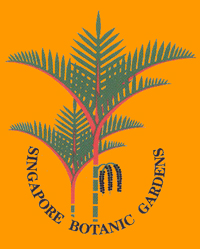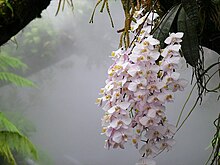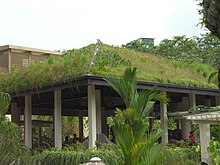Singapore Botanic Gardens
[1] The Botanic Gardens has been ranked Asia's top park attraction since 2013, by TripAdvisor Travellers' Choice Awards.It played a pivotal role in the region's rubber trade boom in the early twentieth century when its first scientific director, Henry Nicholas Ridley, headed research into the plant's cultivation.[6] More than 10,000 species of flora are spread over its 82 hectares (200 acres) area, which is stretched vertically; the longest distance between the northern and southern ends is 2.5 km (1.6 mi).The Garden's main task was to evaluate cultivation crops which were of potential economic importance, including those yielding fruits, vegetables, spices and other raw materials.Lawrence Niven was hired as superintendent and landscape designer to turn what were essentially overgrown plantations and a tangle of virgin rainforest into a public park.This included a series of “interconnecting pathways and promenades, a levelled parade area for military bands to play music... and the establishment of ornamental planting”.The Singapore Agri-horticultural Society ran out of funds, which led to the colonial government taking over the management of the gardens in 1874.Due to the high upkeep of the zoo at the gardens, in 1903, the colonial government decided to sell all the animals and birds and shut it down.During the Japanese occupation of Singapore from 1942 to 1945, Hidezo Tanakadate (田中館秀三), a professor of geology from Tohoku Imperial University, learned of the possibility that the Gardens and Museum might be looted due to the occupation, and negotiated directly with general Tomoyuki Yamashita to gain control of the Singapore Botanic Gardens and the Raffles Museum.The Japanese government and army were unwilling to fund the institutions, however, and Tanakadate had to pay for maintenance and staff salaries from his own pocket.Tanaka returned to Japan in July 1943, and Dr. Kwan Koriba [ja], a retired professor of botany from the Kyoto Imperial University and secretary-general of the Imperial Japanese Army's Malayan military administration department's general affairs department, was appointed director to the Gardens and Museum, posts he held until the end of the war.The Learning Forest showcases the best of tropical trees that grow under local conditions and strengthen the Botanic Gardens' position as a premier institute for research, conservation and education.[16] Also included is a flood protection scheme for the main shopping district of Orchard Road and its surroundings and a water detention pond with capacity to hold excess storm-water of about 15 Olympic-size pools.The ground level serves as an exhibition area, showcasing information on the different hybrids named after VIPs who have visited the garden.There are also interactive exhibits that teach how photosynthesis takes place, and a mini-garden that showcases how plants may be used to make dyes, beverages or as herbs.An official application for Singapore Botanic Gardens to be listed as a World Heritage Site was submitted to UNESCO in January 2014.A 700-page nomination dossier was compiled and written up over one-and-a-half years, led by the National Heritage Board's (NHB) preservation of sites and monuments division and the Botanic Gardens director, Dr Nigel Taylor, who was also involved in the Royal Botanic Gardens at Kew's own UNESCO bid from 2000 to 2003.As part of the process, the dossier had to seek the assessment of the International Council on Monuments and Sites (ICOMOS), a separate professional association.











ChineseSymphony LakeTanglinCentral RegionSingaporeCoordinatesNParksBotanic GardensNapierUNESCO World Heritage SiteSessionHistory of SingaporeEarly historySrivijayaTemasekLong Ya MenBan ZuKingdom of SingapuraMalacca SultanateJohor SultanateFoundingStraits SettlementsJapanese OccupationFall of SingaporeSook ChingDouble Tenth incidentPost-war periodMaria Hertogh riotsAnti-National Service RiotsInternal self-governmentHock Lee bus riotsSingapore Glass Factory strikesPulau Senang prison riotsMerger with MalaysiaSingaporean referendumOperation ColdstoreRace riots in SingaporeMacDonald House bombingRepublic of SingaporeASEAN Declaration1969 race riots of SingaporeLaju incidentOperation SpectrumEmbassies attack plotBus drivers' strikeLittle India riot2018 North Korea–United States Singapore SummitCOVID-19 pandemicTimelineMilitaryOrchard RoadWorld Heritage SiteTripAdvisorHenry Nicholas RidleyMalayan peninsulaNational Orchid GardenorchidVanda Miss JoaquimCyrotostachysGovernment HillStamford RafflesnaturalistcultivationHoo Ah KayBoat Quaylandscape designervirgin rainforestpublic parkKew GardensMalayaNathaniel CantleyHolttum HallhybridisationEric HolttumgazeboJapanese occupation of SingaporeTohoku Imperial UniversityTomoyuki YamashitaRaffles MuseumHolttumEdred John Henry CornerKyoto Imperial UniversityMurray Ross HendersonBukit Timah RoadPhalaenopsis philippinensisHumphrey BurkillDendrobiumPrincess DianaMargaret Thatcher× RenantandaAkihitoMasako Kotaishi HidenkaElizabethGloria Macapagal ArroyoTan Tock SengTan Tock Seng HospitalBromeliaceaetropical rainforestBukit Timah Nature ReserveTijuca ForestZingiberaceaeNational Parks BoardphotosynthesisYad VashemSaracaSaraca declinataChopinSwan LakeSingapore Symphony OrchestraSingapore Chinese OrchestraFrédéric Chopinone-Michelin-starredNational Biodiversity CentreLepidodendronsclubmossesNational Heritage BoardRoyal Botanic Gardens at KewInternational Council on Monuments and SitesTembusuSingaporean five-dollar billBae Yong-joonBlack swanCalophyllum inophyllumSydney HarpleyBotanic Gardens MRT stationNapier MRT station